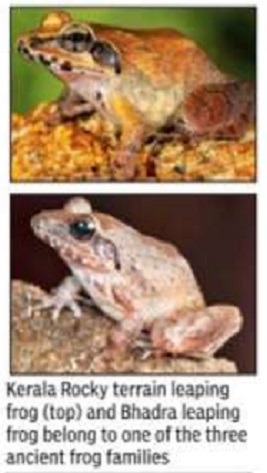Frogs: India
(→Microhylid genus) |
(→Western Ghats, December/ 2017: New night frog species found- Nyctibatrachus mewasinghi) |
||
| Line 296: | Line 296: | ||
Frogs in the genus Nyctibatrachus, commonly known as night frogs, are found only in the Western Ghats mountain range. The addition of the Mewa Singh’s night frog to this group brings the total number of night frogs to 36. | Frogs in the genus Nyctibatrachus, commonly known as night frogs, are found only in the Western Ghats mountain range. The addition of the Mewa Singh’s night frog to this group brings the total number of night frogs to 36. | ||
| + | =See also= | ||
| + | [[Delhi: Wildlife (Fauna)]] | ||
| + | |||
| + | [[Category:China|F FROGS: INDIAFROGS: INDIA | ||
| + | FROGS: INDIA]] | ||
| + | [[Category:Fauna|F FROGS: INDIAFROGS: INDIA | ||
| + | FROGS: INDIA]] | ||
| + | [[Category:India|F FROGS: INDIAFROGS: INDIA | ||
| + | FROGS: INDIA]] | ||
| + | [[Category:Sri Lanka|F FROGS: INDIAFROGS: INDIA | ||
| + | FROGS: INDIA]] | ||
Revision as of 10:23, 4 March 2021
This is a collection of articles archived for the excellence of their content. |
Contents |
Burrowing frogs
Four new species in the Western Ghats/ 2017
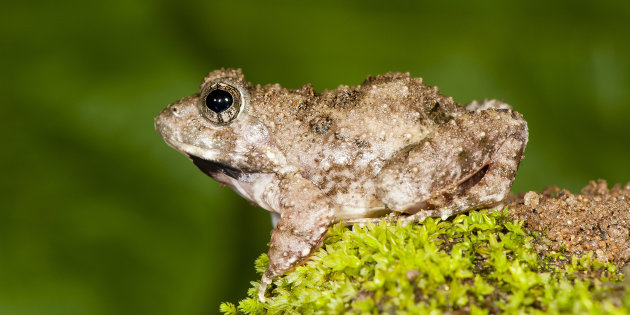

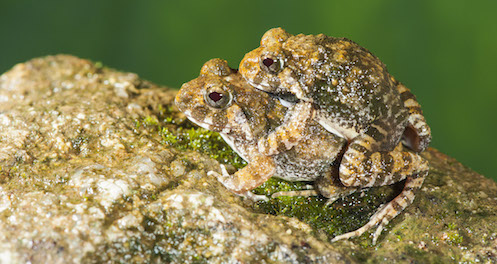
Delhi University researchers discover four new burrowing frogs in the Western Ghats.
A PhD student from Delhi University has discovered four new species of burrowing frogs in the Western Ghats, further cementing the region's place as a global biodiversity hotspot with an unprecedented rate of new frog discoveries in the last decade.
The findings are the result of five years of extensive research by Delhi University student Sonali Garg, and her supervisor Professor SD Biju, who is also known as the 'Frog Man Of India'. The species belong to the Indian frog genus Fejerarya, but are unique because of their ability to burrow using their hind legs.
Discovered in Kerala and Maharashtra, the frogs were confirmed as new species by using an integrated taxonomic approach that included DNA studies, detailed morphological comparisons and bio-acoustics. They include the Maohrahan's Burrowing Frog discovered in the Agasthyamala Hills in south Kerala, the Kadar Burrowing Frog, discovered in the Vazhachal forest in Kerala, the CEPF Burrowing Frog found in Amboli in Maharashtra, and the Neil's Cox Burrowing Frog found in the Parambikulam tiger reserve in Kerala.
"Burrowing frogs are very rare, cryptic and difficult to find. Only 7-8 out of the 230 frog species in the Western Ghats are burrowing frogs," Biju told HuffPost India. "While most frogs in the Western Ghats can be easily spotted during the monsoon, these frogs can be seen for only two to three weeks in June and July. Otherwise, they stay hidden underground or under wooden logs." This also makes these frogs the most susceptible to weather patterns. Since they only breed for a very short period of time, any changes in weather patterns can affect their numbers.
"Our study highlights a fairly common group of frogs that is usually found closer to human habitations but is still not documented properly. More extensive studies are required to scientifically identify and describe the Western Ghats frogs which are already facing extinction threats from various human activities," Garg, who conducted this study as part of her PhD research at Delhi University, said.
In February, Garg and Biju had announced the discovery of four news species of the world's smallest frogs in the Western Ghats. The frogs were so tiny that they could even sit on a finger nail. There has been an exponential increase in the number of new amphibian species discovered in the Western Ghats in the last decade. Out of the 1581 new species of amphibians discovered between 2006 and 2015, the second-highest number were from the Western Ghats-Sri Lanka biodiversity hotspot, numbering approximately 159. Out of these, 103 were from the Western Ghats alone.
In fact, the number of amphibian species discovered in the Western Ghats habitat has nearly doubled within a short span of ten years. Biju attributes the region's biodiversity to factors such as the Western Ghats being isolated from the mainland, as well as the wide array of habitats found within it.
"If you look at the pattern of discoveries, you can see that only about 30-40% of the flora and fauna, especially lower forms of species, in the Western Ghats has been discovered or documented," Biju said. "I believe that we will have to wait for at least another 10 years to fully understand the diversity of life forms in this region.”
However, about one-third of the frogs in the Western Ghats are already threatened by extinction. "Many of these frogs are extremely rare and found only in specific areas," Biju said. "Any small change in the habitat is more than enough to decrease their population.”
Frankixalus (tree hole-breeding frogs)
Biju finds rhacophorid genus in the NE/ 2016
The Times of India, Jan 21 2016
Manash Gohain
New frog genus discovered in NE forests
Professor Sathyabhama Das Biju of DU, popularly known as the `frogman of India', and his team of researchers have discovered a new genus of tree holebreeding frogs in the forests of India's northeast and China. These frogs are special because the tadpoles feed on their mother's eggs.
The team comprised PhD students of Biju and researchers from National Centre for Cell Science (Pune), University of Peradeniya (Sri Lanka), Vrije Universiteit Brussel (Belgium) and American Museum of Natural History (USA).
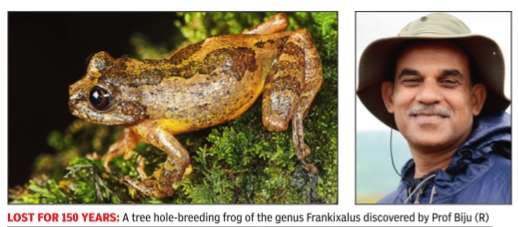
The findings have been published in a paper titled Frankixalus, a new rhacophorid genus of tree hole-bre eding frog with oophagous tadpoles' in the current is sue of international journa PLoS One. The genus has be en named Frankixalus after Professor Franky Bossuyt of Vrije Universiteit Brusse for his contribution to amp hibian research.
“In 1870, British natura list T C Jerdon collected two specimens of a tree frog from forests of Darjeeling and preserved them at Natural History Museum, London. The frog was not found in the wild for over 150 years and was scientifically deemed lost. It remained a mysterious creature--a victim of mistaken identity ever since,“ Biju said.
The overlooked specimens in London were pulled out of the museum cabinets and studied, and the team conducted extensive field work for three years in the forests of Arunachal Pradesh, Manipur, Meghalaya, Naga land, Tripura, Sikkim and Darjeeling (West Bengal).The samples were analysed in the genetics lab of DU.
“Our discovery indicates that documentation of Indian amphibians is still incomplete. Unfortunately , many of them face various extinction threats, especially due to habitat loss and fragmentation. Several populations of the new genus were found in highly disturbed habitats, which is a reason for concern. Taking any conservation effort for amphibians will indirectly conserve several other life forms of that area,“ said Biju.
Biju and his team had in 2014 discovered seven new species of golden-backed frogs from the Western Ghats-Sri Lanka global biodiversity hotspot.
Indirana paramakri, Indirana bhadrai (leaping frogs)
Two new species discovered by Biju/ 2016
Manash Gohain, Two new species croak at W Ghat, Nov 17 2016 : The Times of India
Two new species of frogs have been discovered by Professor Sathyabhama Das Biju, popularly called India's Frogman. This takes his count to 80 since his first discovery in 2003.The DU scientist's latest find took place in the Western Ghats in Karnataka and Kerala. The species from Kerala has been given the common name of Rocky terrain leaping frog (scientific name: Indirana paramakri), while the one in Karnataka is called Bhadra leaping frog (Indirana bhadrai).
This June, Biju's team chanced upon a strange mating process of the Bombay night frogs, while in 2014 he and his team had discovered seven species in the Western Ghats. In 2012, a team led by him had revealed to the world a new family of legless amphibians known as caecilians. Other successes of the Frogman have come in the forests of Nagaland.
The two frogs species belong to the Ranixalidae family, one of the three ancient frog families that diversified on the Indian landmass long before the extant frogs appeared in this region. “Nearly half of the currently recognised species in this family have been described only in the last three years,“ said Biju, adding that a new genus had been recognised to accommodate three previously known species.
Biju added, “Our surveys in the Western Ghats suggest the further presence of undescribed diversity in this group, thereby increasing all estimates of the family's diversity estimates.“
Biju and doctorate scholar Sonali Garg of the Department of Environmental Studies, DU, conducted extensive sampling of Indirana frogs from across the Western Ghats, and performed DNA barcoding for 200 ranixalid samples.
Megophrys (horned frogs)
4 new species found in NE/ 2018
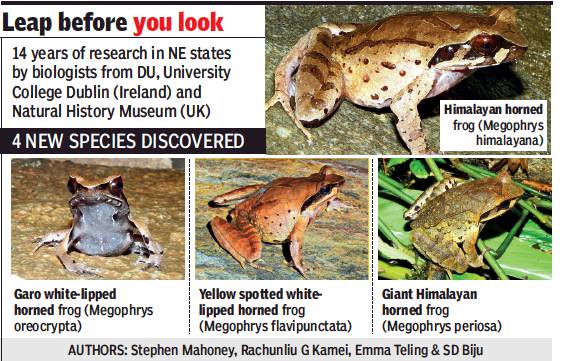
From: Manash Gohain, 4 new frog species found in NE after 14-year study, November 20, 2018: The Times of India
Four new species of ‘horned frogs’ have been discovered in the forests of northeastern states, which has forced scientists to revise some of their previous estimates.
This has been the result of a14-year study that was a joint effort by Delhi University, University College Dublin, Ireland, and Natural History Museum (UK). The study found that Jerdon’s white-lipped horned frog is not as wide ranging as previously thought. It’s restricted to a few recently discovered populations in Nagaland and Manipur, and near Sohra (Cherrapunjee) in Meghalaya where it was first discovered in 1870 by British naturalist Thomas Caverhill Jerdon.
The discovery resulted from professor Stephen Mahony’s PhD work carried out at University College Dublin and DU (supervised by professor Emma Telling and professor S D Biju). Biologists were investigating a group of six closely related species of horned frogs (named due to a fleshy, hornlike protrusion on the upper eyelids). Historical literature and a large number of museum specimens were examined by the lead author, including seven years of extensive fieldwork in some of the wettest and difficult terrains in the world by the Indian team.
The four new species have been named as Himalayan horned frog (megophrys Himalayana), Garo white-lipped horned frog (megophrys oreocrypta), yellow spotted whitelipped horned frog (megophrys flavipunctata), and giant Himalayan horned frog (megophrys periosa). The study was published on November 19 as a monograph in the scientific journal Zootaxa. The implication of this study is that all remaining frog populations throughout Asia could represent unique new species that are yet to be named.
Mahony, the lead author of the study, said, “The discovery of relatively large new species of frogs is not very common these days, and this study highlights how an animal that scientists thought they knew well for the past 150 years can surprise us when we take a closer look at them. We have found that all species in this study have a smaller geographic range than previously thought. As Asia’s remaining forests are rapidly shrinking due to human activities, and the streams where these frogs reproduce become polluted, the urgency of knowing where these unique species live is vital if there is any chance to protect them from extinction.”
Of the four, the smallest grow to a size of 5.7-7.5cm (yellow spotted white-lipped) and the largest grow to 7.1-11.2cm (giant Himalayan).
“Northeast India is rich in amphibian diversity but despite being part of two globally recognised biodiversity hotspots (Himalayas and Indo-Burma), this region is neglected as compared to the Western Ghats hotspot. Our discovery highlights the need to carry out systematic research in northeast India to fully understand and conserve its unique frog fauna,” Biju said.
Microhylid genus
Micryletta aishani
Manash Gohain, June 12, 2019: The Times of India
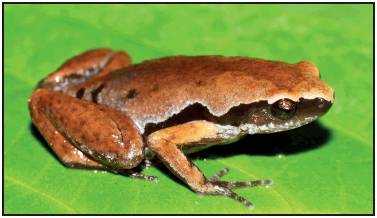
From: Manash Gohain, June 12, 2019: The Times of India
A new frog species has been discovered in the Northeast by a team of scientists from Delhi University and Wildlife Institute of India in collaboration with researchers from Indonesia and the US. This one belongs to the Microhylid genus and has been named Micryletta aishani.
The first known species of the genus was found in Sumatra, Indonesia. At present, the genus has only four recognised species that are commonly known as paddy frogs. But the Northeast one was confirmed as a new species after detailed comparison of both DNA and morphology with all previously known species across Southeast and East Asia.
What has surprised scientists is that the new species isn’t found far from human habitat.
“Our discovery shows that even fairly common frogs usually found closer to human habitations are still not documented properly. More extensive studies are required to scientifically identify and describe the Northeastern frogs which are already facing extinction threats from various human activities,” said Abhijit Das of Wildlife Institute of India. The past decade has witnessed an exponential increase in the number of new amphibian species discovered in India, particularly the Western Ghats.
“The actual number of frog species in Northeast India is much higher than the current estimates. What remains is for us to carry out dedicated surveys in unexplored regions and undertake comprehensive studies using integrative taxonomy, just like the Western Ghats where the number of known amphibian species has nearly doubled within a short span of 10 years, making it one of the leading biodiversity hotspots in the world with an unprecedented rate of new frog discoveries,” said professor S D Biju from DU.
The new species is named aishani after the Sanskrit word aishani that means ‘northeast’. It differs from other paddy frogs due to its reddish-brown back, dark streaks and ash grey mottling on the lateral sides, shape of the snout and absence of webbed feet.
The DNA analyses in the new study also indicate the presence of more unknown species in this genus in Laos, Thailand, and Vietnam.
The new species was discovered based on specimens collected from a degraded forest area in Cachar district of Assam. “It is likely to be more widely distributed in Northeast India, particularly the Indo-Burma biodiversity hotspot region that lies south of Brahmaputra. It could very well be present in Bangladesh and Myanmar,” said Sonali Garg of DU.
Mysticellus genus
Indian researchers have discovered a new species of frog - in a roadside puddle.
Sonali Garg, a PhD student at Delhi University, and her supervisor SD Biju found the new species in the Western Ghats, a biodiversity hotspot in southern India.
The species belongs to a new Indian frog group or genus which the scientists have named Mysticellus.
The name is derived from Latin and means mysterious and diminutive. The scientists discovered the narrow-mouthed frog after three years of extensive explorations, and have confirmed that it represents an entirely new species and genus of microhylid frogs.
The new genus is currently known only in a single locality. "Our discovery of this new frog genus from one of the most explored and researched regions in the Western Ghats indicates that documentation of amphibians in this globally recognised biodiversity hotspot is still far from being complete," says Sonali Garg.
"This frog went unnoticed until now probably because it appears for less than four days for breeding activities and lives a secretive lifestyle for the rest of the year.”
A number of new frog species have been discovered in the Western Ghats in the past decade, making it one of the leading biodiversity hotspots in the world.
"At the same time, Indian amphibians face various extinction threats, especially due to habitat loss and degradation. The only known population of the new genus is found in a wayside area disturbed with vehicular movement, plantation activities and human settlements," says Ms Garg.
"Since little is known about the habitat requirements and the distribution range of the new frog, the specific site needs to be preserved to protect this frog.”
A new tadpole that burrows through sand was discovered in Western Ghats in 2016, and an extraordinary tree frog thought to have died out more than a century ago was also rediscovered in the same year. In 2017, four new species of burrowing frogs were discovered in the region.
Nyctibatrachus (night frogs)
Manash Gohain, 4 miniature frogs that can sit on coin or thumbnail, Feb 23 2017: The Times of India
India now has the world's smallest known frogs.Seven such species were discovered by Professor S D Biju, known as the `Frogman of India' for his work on the amphibians, and his team from Delhi University in the Western Ghats. Of the newly discovered species, four are true miniatures with body lengths of 10-15 mm and can comfortably sit on a coin or a thumbnail.
These species belong to the genus Nyctibatrachus, commonly known as night frogs.Evolutionary biologist David Wake of the University of California, Berkeley, expressed surprise because the known nyctibatrachids are relatively larger.
Dr Ariadne Angulo, head of Amphibian Special Group at the International Union for Conservation of Nature, said the immediate priority for these newly described species, after being formally recognised as such, would be to assess their global extinction risk.
Unlike other frogs in the genus that are predominantly stream dwelling, the new miniature frogs were found among damp forest leaf litter or marsh vegetation. “The miniature species are locally abundant and fairly common but they have probably been overlooked all these years because of their extremely small size, secretive habitats and insect-like calls,“ said Sonali Garg, who undertook this study as part of her PhD research at DU.
This discovery of new species of ancient origin can provide useful insights into the evolution of endemic frog lineages in the Western Ghats, which is a global amphibian hotspot.
The past decade has witnessed a big increase in the number of new amphibian species found in this region. Of the 1,581 total new amphibians species reported across the world between 2006 and 2015, around 182 were from the Brazilian Atlantic forest, followed 159 in the Western Ghats-Sri Lanka biodiversity hotspot, with 103 species from the Western Ghats region alone.
Many of these new species are facing threats from human activity. Dr Angulo said that because several of the species have been identified as being range-restricted and impacted by threats, it was important to conduct their extinction assessments. “Once the extinction risk is assessed, both research and conservation actions can be tailored accordingly ,“ she said.
Night frogs, Bombay-
The Times of India, Jun 15 2016

Manash Gohain
Discovered: Konkan frog species' touchless sex
The female does much of the courting, the male is furiously possessive of her, but when it comes to intercourse, they make Victorian prudes seem rather forward.Meet the Bombay night frog, an oddity in the anuran world that reproduces without the mates touching each other. The complex world of frogs and toads comprising about 7,000 species has its own little Kama Sutra with six mating positions called amplexus modes (from the Latin word for `embrace') because the male clasps the female about the back during intercourse. But researchers led by Delhi University professor S D Bihu have found that the Bombay night frog adopts a seventh distinct position.
Called dorsal (back) straddle, it has the male spreading itself over the female's back with its feet clutching or resting over leaves and twigs on the sides. Bihu said the male appears to release sperm over the female's back and then moves away . After that, the female lays her eggs, which are fertilised by the sperm trickling down her back. In other frog species, females usually lay eggs during amplexus and males simultaneously release sperms to fertilise them.
“This is a frog with a re markable reproductive behaviour, and this discovery is fundamental to understanding the evolutionary ecology and behaviour in anuran amphibians,“ said Biju.
Bombay night frogs are found mainly near fast-flowing streams in the Western Ghats. They are classified as an ancient group of frogs that diversified 7080 million years ago. In the breeding season, they can be seen calling from the ground and over hanging vegetation in large numbers, soon after sunset.
The species also shows other rare sexual traits. For instance, the female, as also the male, croaks the mating call during breeding season, a behaviour seen in only 25 species worldwide. Fights between competing males are also common, and last until the intruder is thrown out.
The research team also observed eggs of Bombay night frog being eaten by snakes. It's the first documented observation of snakes eating frog eggs in India.
The research team comprising scientists from University of Delhi, National Centre for Biological Sciences, Bengaluru, and University of Minnesota, USA, observed the frogs in the field for 40 nights during monsoon months between 2010 and 2012. Their findings were published in the journal `PeerJ'
The unique mating position of Bombay night frogs
The frogs are secretive, breed only at night, and always at the peak of monsoon season, but researchers have finally identified their remarkable mating habits
They mostly come at night. Moments after sunset, and calling as they move, the Bombay night frogs climb high into the trees that overhang rivers swollen by the warm monsoon rains in the forests of Western Ghats in India.
And then the action begins. On rain-soaked leaves, branches and tree trunks, the amphibians pair up. The female sends a willing signal by backing towards her male and touching his head with her toes. What follows is a mating position never seen before in the wild world of frog sex.

Ian Sample, Science editor, The Guardian/ PeerJ
The Bombay Night frogs in Dorsal straddle: a new amplexus mode in frogs. Until Bombay night frogs fell under the spotlight, scientists had identified six mating positions among the world’s 6,650 frog species.
“It’s remarkable,” said Sathyabhama Das Biju, an expert on amphibians at the University of Delhi, who has published a comprehensive report on the frogs’ sexual antics. “So far, this mating position is known only in Bombay night frogs.”
It was 2002 when Biju first witnessed Bombay night frogs mating. But the animals are secretive, they breed only at night, and always at the peak of monsoon season. He got the odd glimpse, but not much else. It took eight more years for Biju to launch a study dedicated to unravelling the beasts’ mysterious breeding habits.
Now, after 40 nights in the forest, Biju has amassed enough field notes, photographs and infrared night-vision video footage from 13 encounters to describe the breeding habits of the frogs, Nyctibatrachus humayuni, in detail.
Until Bombay night frogs fell under the spotlight, scientists had identified six mating positions among the world’s 6,650 frog species. The male might clasp the female around the waist, grab her armpits, hold her head, attach himself to her back with a gluey substance, sit back-to-back, or perhaps sit on her head. But the Bombay frogs do none of these.
Before now, scientists had identified six mating positions among the world’s 6,650 frog species.
Writing in the journal PeerJ, Biju and his colleagues describe how they filmed males clambering on to females. What happened next was unexpected. Instead of clasping his partner, the male took hold of nearby branches or leaves to steady himself. He then appeared to release his semen on to the female’s’ back. Soon afterwards, the female shrugged the male off, and laid her eggs, which, the researchers hypothesise, are “fertilised by semen running down her back and hind legs.”
The researchers discover their remarkable findings.
Asked why the frog might have adopted the unusual approach to mating, Biju said: “We have no idea.” But the new position does have a name: the dorsal straddle. “It differs from the other six positions because the male does not grasp the female under her armpits or head, but instead places his hands on the leaf, branch or tree trunk the pair is sitting on,” he noted.
The 5cm-long Bombay night frog is endemic to the Western Ghats, a mountain range and world heritage site that runs parallel to the west coast of India, spanning a thousand miles from Gujarat to Kerala. While males of all frog species call for mates, Biju’s field recordings reveal that female Bombay night frogs issue their own calls, making them one of only 25 frog species known to do so. He also recorded fights among males, with interlopers forcefully barged out of the way, and predation of the frogs’ fertilised eggs, with 80% of a female’s clutch being eaten by nearby snakes.
Western Ghats, February/ 2017: 7 new night frog species found
T. Nandakumar, Tiny frog species found in Western Ghats, February 21, 2017: The Hindu
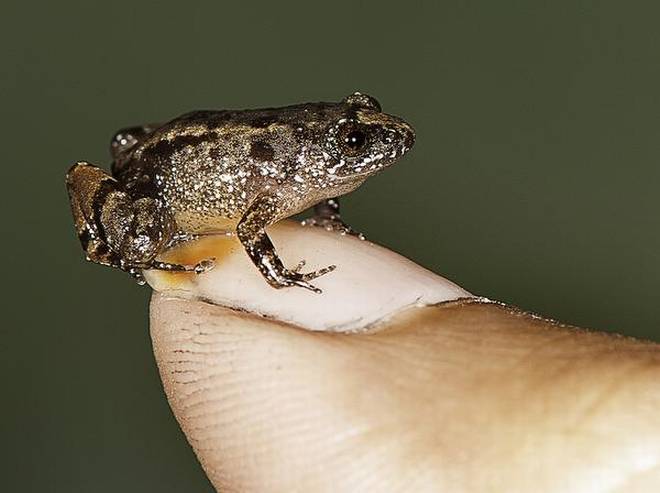
Five of the seven new ‘Night Frogs’ have small ranges and their habitat is under threat, say scientists
Scientists exploring the forests of the Western Ghats have come across four new species of tiny frogs no bigger than a human thumbnail, which make a distinctive chirping sound comparable to the one of a cricket.
These species are among the seven new ‘Night Frogs’ discovered by a team of researchers from the University of Delhi and the Kerala Forest Department, who spent five years surveying the global biodiversity hotspot.
‘Night Frogs’ belong to the Nyctibatrachus genus endemic to the Western Ghats and represent an ancient group of frogs that diversified on the Indian landmass approximately 70 to 80 million years ago.
The scientists were surprised by the relative abundance of the previously unknown species at their collection localities.
“The minuscule frogs have probably been overlooked because of their extremely small size, secretive habitats and cricket like calls,” says Sonali Garg, who undertook the study as part of her Ph.D research at the University of Delhi.
The scientists used an integrated taxonomic approach that included DNA studies, detailed morphological comparisons and bioacoustics to confirm the new species. The findings have been published in the latest issue of PeerJ, an open access journal.
Hydroelectric project
While turning the spotlight on the amphibian diversity of the Western Ghats, the discovery also highlights the threat posed by human activities to the species.
The Athirappilly Night Frog was found close to the Athirappilly waterfalls, the proposed site of a hydroelectric project, while the Sabarimala Night Frog was discovered near the hill shrine which receives lakhs of pilgrims every year. The Radcliffe’s Night frog and the Kadalar Night Frog were reported from plantation areas.
“Over 32% of the frog species in the Western Ghats are already threatened with extinction. Out of the seven new species, five face considerable anthropogenic threats and require immediate conservation,” says Professor S.D Biju, who led the study and has formally described over 80 new species of amphibians from India.
Restricted range
“Because several of the new species have been identified as being range restricted and impacted by threats, it is important to assess their extinction risks and tailor conservation strategies for both species and habitats,” said Ariadne Angulo, co-Chair, Amphibian Specialist Group, IUCN, in an emailed response.
The discovery has taken the total number of known Nyctibatrachus species to 35, of which 20% are diminutive in size (less than 18 mm).
As many as 103 new amphibian species have been described from the Western Ghats region between 2006 and 2015.
Western Ghats, December/ 2017: New night frog species found- Nyctibatrachus mewasinghi
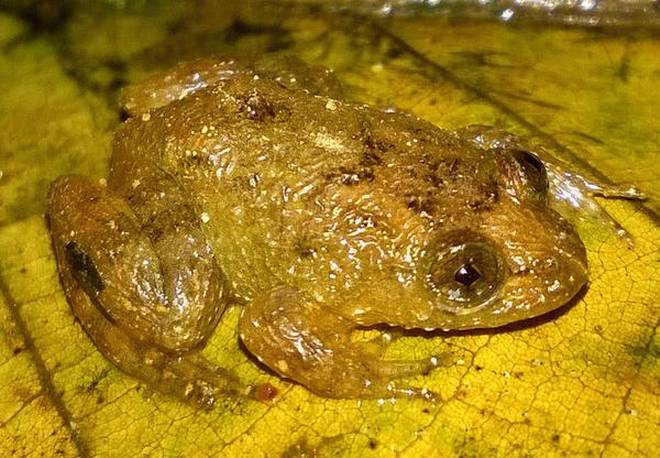
From: January 1, 2018: The Hindu
Nyctibatrachus mewasinghi is a new species of night frog from Western Ghats
A new frog from Kerala is the latest contribution to the spurt in amphibian discoveries across India: scientists have just discovered the Mewa Singh’s Night frog, belonging to a genus endemic to the Western Ghats, from Kozhikode’s Malabar Wildlife Sanctuary.
According to a scientific paper published on December 26 in The Journal of Threatened Taxa (an international journal on conservation and taxonomy), the new night frog Nyctibatrachus mewasinghi is light brown in colour with an off-white underside, and sports faintly wrinkled skin with prominent granular projections.
Since many frogs in the genus Nyctibatrachus look similar, scientists from institutes, including the Indian Institute of Science Education and Research (Pune, Maharashtra) and the Zoo Outreach Organisation (ZOO, Coimbatore, Tamil Nadu) used both physical characteristics as well as genetic methods to confirm the frog as a new species. Using tissue samples of 10 collected specimens, the scientists analysed portions of two genes and found that it varied enough from other closely-related species to make the Mewa Singh’s night frog a different species. They also found that the frog’s genetically closest relatives are the Athirappilly night frog (found south of the Palakkad Gap in Thrissur and Idukki) and the Kempholey night frog (found in the northern Western Ghats of Kerala and Karnataka).
Morphologically, the Mewa Singh’s night frog can be distinguished from these similar-looking and genetically close relatives by several physical characteristics, including the pattern of its webbed fingers and toes. The frog has been named after wildlife scientist Mewa Singh, in honour of his contributions to behavioural ecology and primate studies.
The new frog is currently known only from Peruvannamuzhi in the Malabar Wildlife Sanctuary, where the scientists found it in a small stream running along the Peruvannamuzhi dam.
“It is an interesting species because of this currently-known restricted distribution,” says author Sanjay Molur of ZOO. “We will need more surveys to understand these frogs better.”
Close relative
What is unusual is that the frog’s genetically closest relative — the Athirappilly night frog — is found far away and across the Palakkad gap, says Mr. Molur. “Hence the species is also unique from a genetic perspective,” he says.
Frogs in the genus Nyctibatrachus, commonly known as night frogs, are found only in the Western Ghats mountain range. The addition of the Mewa Singh’s night frog to this group brings the total number of night frogs to 36.
